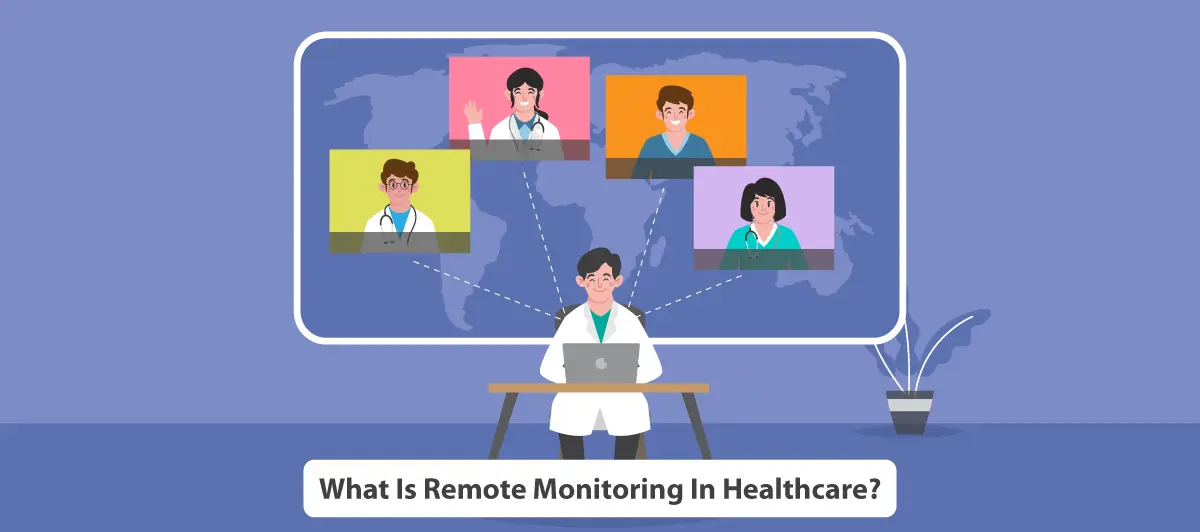What Is Remote Monitoring In Healthcare: All You Need To Know
Quick Summary: Remote Monitoring In Healthcare is a transformative approach that leverages technology to enhance patient care. a Remote patient monitoring program helps healthcare providers track the health of their patients remotely. To understand everything about the What is Remote Monitoring in Healthcare, read this blog.
Introduction
The approach of patient care is transforming with remote patient monitoring in healthcare. In an era where convenience and accessibility are important, remote patient monitoring empowers patients and healthcare providers alike.
Additionally, it enables individuals to take charge of their well-being while offering doctors real-time insights into a patient’s condition. Whether it’s tracking vital signs, managing chronic diseases, or ensuring post-operative recovery, remote patient monitoring establishes a lifeline that transcends the barriers of time and distance.
But it’s not just about convenience. It’s about saving lives. With remote patient monitoring early detection of health issues becomes a reality, reducing hospitalizations and improving overall healthcare outcomes.
So, let’s read this blog and understand What is Remote Monitoring In Healthcare and all about it.
What Is Remote Monitoring In Healthcare?
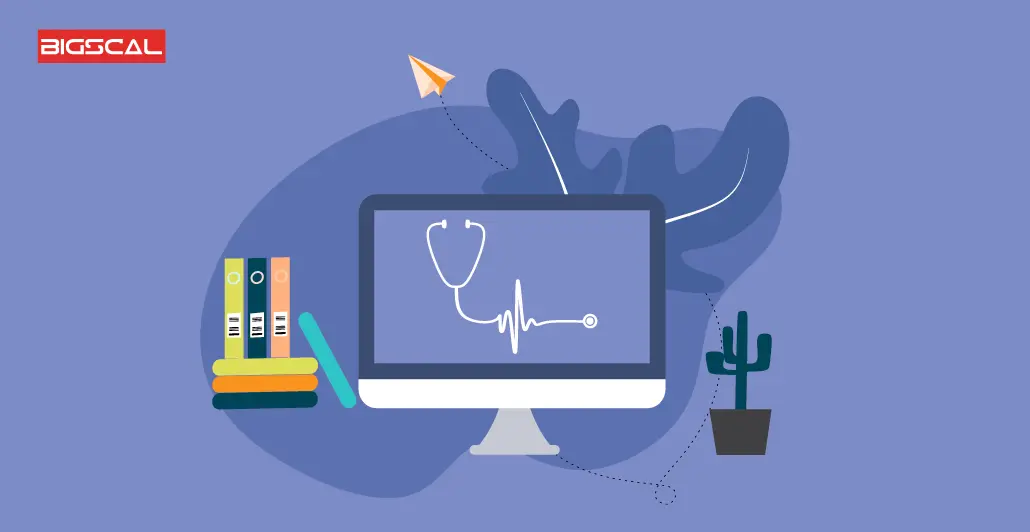
Remote patient monitoring established in healthcare refers to the use of technology to collect and transmit patient data from a location other than a traditional healthcare setting, such as a patient’s home. It is another type of patient management software. This technology enables the healthcare service dealers to keep track of the patient’s vital indicators, signs, or other health specifics in real-time.
It can be such innovations as wearable monitoring devices, smartphone applications, or telemedicine solutions and it is most effective when used for the treatment of chronic diseases. Further, it monitors patients after they have been operated on, as well as takes care of the health of people who cannot access a clinic.
Remote patient monitoring is beneficial as it reduces the number of in-person meetings with the doctor and potentially promotes more active patient management.
Read more: Types Of Telemedicine: Benefits, Types, And Examples
Importance Of Remote Monitoring In Healthcare
Remote patient monitoring is so important in healthcare as benefit the healthcare professionals and patients in various ways, you may read below:
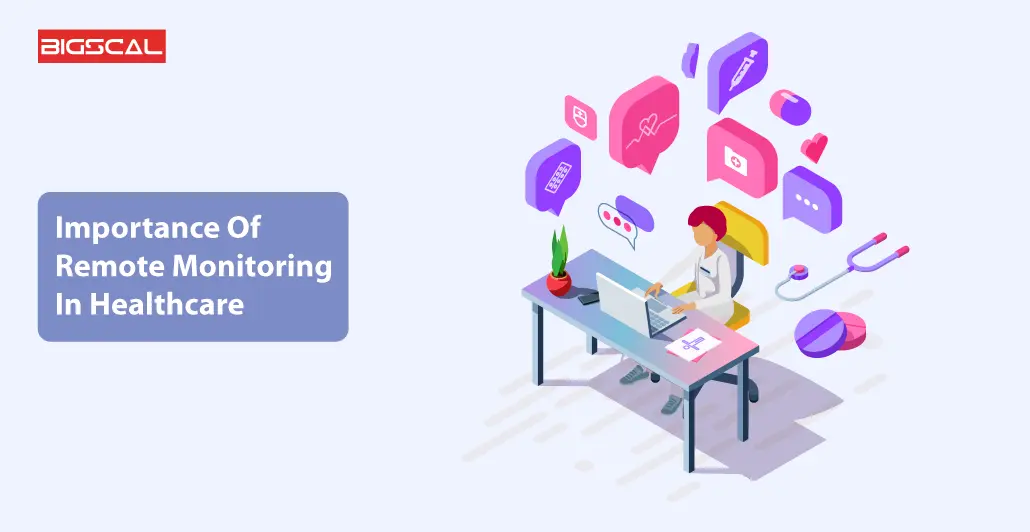
Early Detection
Remote patient monitoring allows doctors to have medical devices to keep a constant track on patients’ health from a distance. This is especially important for detecting potential health issues early. For instance, in the case of patients suffering a heart condition, monitoring devices can track vital signs like heart rate and blood pressure.
If these readings deviate from the normal range, the system can alert both the patient and their doctor, enabling swift intervention. Early detection can prevent minor problems from becoming major health crises, ultimately saving lives.
Chronic Disease Management
Patients with chronic diseases such as diabetes or hypertension often require ongoing care and monitoring. Remote patient monitoring makes this process more convenient. Patients can measure their vital signs or their blood pressure or blood sugar levels at home, and the data is transmitted to their health care providers.
This helps in managing chronic conditions more effectively, ensuring that patients receive timely adjustments to their treatment plans. It also reduces the need for frequent in-person visits, improving the overall quality of the health system, of life for and patient satisfaction scores for individuals with chronic diseases.
Reduced Healthcare Costs
“Remote therapeutic monitoring: remote Patient monitoring reduces the financial burden on patients and healthcare systems. By allowing doctors to keep an eye on patients’ health from a distance, it reduces the need for frequent in-person visits, which can be costly.
Patients can also detect potential issues early, preventing expensive emergency hospital stays. Furthermore, it helps in managing chronic conditions, reducing the amount patients need to go for extensive treatments.
In nutshell, the remote patient monitoring program not only saves money for both patients and health care providers but also promotes more cost-effective and efficient healthcare delivery.
Enhanced Patient Engagement
Remote monitoring empowers patients to participate in their healthcare actively. It provides them with valuable insights into their health conditions, making them more aware and engaged in managing their health systems and their well-being.
Patients can track their vital signs, medication adherence, and lifestyle choices, fostering a sense of responsibility for their health. This engagement leads to patient adherence, better treatment compliance, faster recovery, and improved overall health outcomes.
Moreover, the ability to communicate with health care providers remotely fosters a strong patient-provider relationship, where patients feel heard and cared for, ultimately leading to better health management.
Provide 24/7 Access In Person Care
Remote patient monitoring allows patients to receive continuous medical attention and support, even when they’re not physically present at a medical facility. Through wearable devices and telemedicine, doctors can track vital signs, and body temperature, making it easier to detect health issues early.
This constant oversight can reduce emergency room visits and hospitalizations. Patients have peace of mind knowing that their health is being actively managed, promoting a more proactive approach to healthcare. It ensures that help is available when needed, which is especially crucial for individuals with chronic conditions.
Personalized Medicine
Remote patient monitoring enables doctors to tailor treatments and interventions to each patient’s unique needs. By collecting and analyzing patient data, such as biometric data such as genetic information, lifestyle habits, and real-time health metrics, doctors can create highly personalized healthcare plans.
This approach maximizes the effectiveness of treatments, minimizes side effects, and enhances overall patient outcomes. It shifts healthcare from a one-size-fits-all model to one that’s customized, optimizing the chances of success for every individual improving the quality of health care everywhere.
Data-Driven Decision Making
Remote patient monitoring in healthcare helps in data-driven decision-making. It involves collecting and analyzing data from patients’ devices, like heart rate monitors or blood glucose meters, in real time. This data provides healthcare professionals with valuable insights into a patient’s health. By tracking trends and changes, doctors can make more informed decisions about treatment plans.
For example, if a patient’s blood pressure starts rising, the system can alert the healthcare team, allowing them to intervene before a serious problem occurs. This proactive approach can lead to better outcomes and more personalized care.
Patient Safety
Remote patient monitoring also significantly enhances patient safety. Continuous data collection and transmission enable early detection of potential issues. If a patient’s vital signs deviate from the normal range, healthcare providers are alerted immediately. This can prevent adverse events and reduce hospital readmissions.
For instance, a patient with heart disease can be closely monitored from home, and any concerning changes in their ECG or heart rate can trigger a prompt response. Moreover, it helps ensure that patients receive timely care, reducing the risks associated with delayed interventions and enhancing their overall safety.
Boost Revenue
Remote patient monitoring in healthcare can significantly boost revenue by reducing hospital readmissions. It allows healthcare providers to keep a close eye on patients’ vital signs and health conditions from a distance.
Catching potential issues early helps prevent costly hospital stays. This means fewer expenses for both patients and healthcare facilities, and it frees up hospital beds for critical cases. Plus, the benefits of remote patient monitoring encourages the use of billable telehealth services, contributing to increased revenue.
Optimize Staff Productivity
Remote patient monitoring technology streamlines healthcare staff’s work. It is a remote patient monitoring program that automates data collection, reducing the need for manual tracking of patient data. Staff can focus on more critical tasks, like direct patient care. It also enables healthcare professionals to keep tabs on a larger number of patients simultaneously, improving efficiency.
This not only optimizes clinical benefits and staff productivity but also minimizes the risk of errors in data recording, ensuring accurate and timely care.
Futuristic Trends In Remote Patient Monitoring In Healthcare
To stay first, we need to stay up-to-date with the latest trends. Thus, to keep you updated futuristic trends we are presenting some most Futuristic Trends. See below:
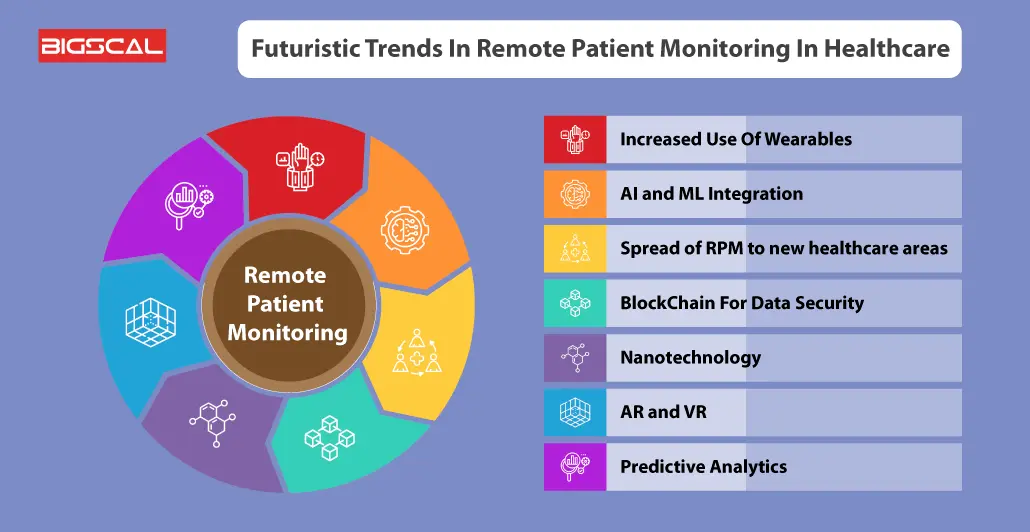
Increased Use Of Wearables
In the healthcare world, people are now wearing smart remote patient monitoring devices can monitor their health, like smartwatches and fitness trackers. These gadgets can track things like heart rate, steps, and even sleep patterns. But in the future, they’ll do even more!
These rpm devices keep an eye on vital signs like high blood pressure and blood glucose levels, sending this data to doctors in real time. This means patients can be monitored without always going to the hospital, making healthcare more convenient and efficient.
AI and ML Integration
Suppose your healthcare team had a super-smart assistant. Well, that’s what AI (Artificial Intelligence) and ML (Machine Learning) can be in healthcare. They can analyze loads of patient’s data to help doctors make better decisions. For instance, they can spot patterns and predict health issues, even before they become a big problem.
This tech isn’t meant to replace doctors but to help them be even better at taking care of patients. It’s like having a knowledgeable sidekick to help patients ensure you get the best possible medical care.
Spread of RPM to new healthcare areas
RPM isn’t just for chronic conditions anymore. It’s branching out to new areas. Think post-surgery check-ins, pregnancy monitoring, chronic care management and even mental health support. The sky’s the limit. Patients can connect with doctors and nurses for expert advice without leaving home.
It’s good for both patients and health care providers, opening doors to innovative ways of at high risk patients staying healthy.
BlockChain For Data Security
Privacy is the MVP in healthcare’s RPM programs. With sensitive patient data floating around, security is a top concern. The future focuses on locking down this info tight. Advanced encryption and cybersecurity measures are a must. Think of it as a digital fortress around your patient’s health status records. Patient trust is key, and with robust security, a successful RPM program can thrive, knowing your data is safe from prying eyes.
Blockchain is like A super-secure digital ledger that records medical data like a lockbox. It keeps your health info safe and private. Hospitals and patients can trust that their data is secure. It makes sharing data between different healthcare organizations and providers easier. Blockchain is like a high-tech security guard for your medical records. In the future, it could revolutionize how healthcare data is handled, ensuring our privacy and security.
Nanotechnology
Nanotechnology is like super tiny tech. We’re talking about things the size of atoms and molecules. Scientists are developing mini machines that can target diseases at the tiniest level. These nanobots can deliver medicines exactly where they’re needed, like tiny doctors inside your body.
The other benefit is that it is able to diagnose diseases at the initial stage when they are not evident. When it comes to the application of nanotechnology in the medical field, it is quite evident that the treatment for various diseases and illnesses will be made more precise and more effective as well. It might benefit us in the future to be able to combat diseases in a manner that we never even contemplated before.
AR and VR
Implementing AR and VR is quickly transitioning the healthcare industry. This means that AR places digital content onto real world to assist the doctors in surgeries by providing 3D images of the symptoms of a particular patient. VR, however, takes the patients through therapy or a simulated environment in controlling the pain. They bring out the improvements in the medical training models, making them more engaging and easier to accomplish.
Patients can also attend telehealth virtual visits through the use of VR, which enhances the feeling of a visit by a doctor and other consultations. These technologies will further redefine the healthcare sector by enhancing diagnostic techniques, treatment, and even the experience that patients, vulnerable clients, or residents have in healthcare facilities.
Predictive Analytics
Health forecast targets the use of data to make future predictions about the health sector. Through the study of past medical records, it would be able to identify which conditions are likely to arise out of control in the future. For instance, it can notify the doctors on deviations in the patient’s heart rates or the ability to take the right doses, thus promoting prevention and treatment. It helps to enhance the patients’ quality of life, as well as the overall saving in healthcare bills in instances of decreased hospitalization.
Also, it helps the health care providers manage limited resources well by providing recommendations on its allocation. Predictive analytics is gradually being incorporated into the provision of healthcare services as a way of customizing treatments and thus creating a better and more efficient framework for enhanced personal patient care.
How Does Remote Patient Monitoring RPM Works?
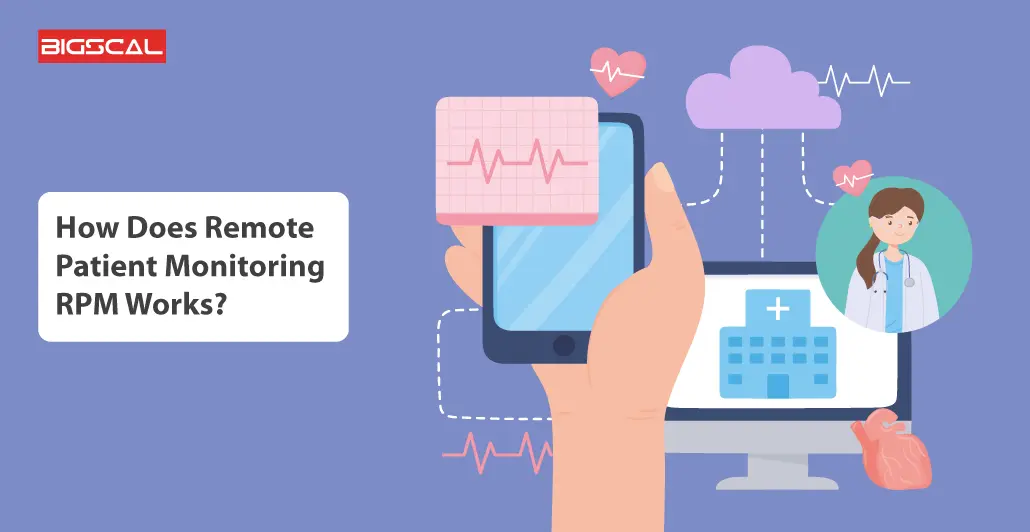
Remote patient monitoring in healthcare functions through a network of devices and sensors. It Collects important patient health data in real-time with the help of different software and devices like patient journey management software or wearables. These data points encompass vital signs, blood pressure monitors, medication adherence, symptom tracking, and more. It helps doctors to understand the condition of their patient and take quick actions. The primary function of RPM is to collect data with accuracy.
Additionally, it aids in disease control through the early detection of health issues, enabling health care providers to intervene. Thereby it reduces hospital readmissions and emergency room visits. RPM facilitates patient engagement as it allows individuals to take an active role in their health management. It allows patients to make decisions, better treatment plans and lifestyle changes.
RPM supports the shift from episodic care to continuous care, which shows a holistic and patient-centric approach. Health care providers can access real-time patient data. Which enables personalized treatment plans and medication adjustments. This not only improves health outcomes but also lowers healthcare costs by reducing the burden of chronic diseases. Moreover, this real time health data also helps in patient flow management software.
RPM’s functions are diverse, including continuous monitoring, early detection, patient engagement, and personalized care. This innovative approach is instrumental in improving patient outcomes and the overall efficiency of the healthcare system by enhancing the quality of care and reducing costs.
For your better understanding we are Outlining some main functions of a remote patient monitoring program:
- Data Collection
- Data Transmission
- Continuous Monitoring
- Early Detection of healthcare
- Emergency Alerts
- Improve in quality healthcare
- Help Doctors to make wise choices
Get a Customize Remote Patient Monitoring Software With Help Of Bigscal
If you are looking for a Remote Patient Monitoring Software and are not able to get a proper solution which can match your unique needs and preferences, then you can collaborate with us. We specialize in creating custom solutions for various sectors, including healthcare organizations.
You can share all your ideas and preferences with us. These can include specific features you need, integration with existing health systems already, and the user interface design, etc. After understanding all your requirements, our team will build a personalized software solution. So, maintain your patient’s health even by a distance.
Conclusion
Thus we are concluding for this blog, we should have presented what remote patient monitoring creates in healthcare more clearly. It is especially lucrative because today’s world is characterized by a low frequency of hospital attendance and increasingly frequent reliance on technologies that allow effective control of chronic diseases. Since remote patient monitoring is an aspect that is now in its antecedent stage, it is safe to assume that this methodology will be indispensably crucial in the era of healthcare in the future – giving more efficient, accessible, and patient-centric care to the clients.
FAQ
Define remote patient monitoring service.
RPM is a process carried out through the application of technological devices with a strategic aim of keeping track of patients’ health information including vital signs, symptoms, and compliance to medication, all from an off-site location. Information contained at such site is updated in real-time terms; hence, it can help the healthcare providers to manage different conditions or diseases, such as the chronic obstructive pulmonary disease or even follow up on patients who have had surgeries. It helped to improve the patient experience and minimize the number of face-to-face meetings during one patient’s treatment.
How does remote call monitoring program work?
A remote call monitoring program can penetrate in a number of ways; for instance, the program may involve taping the call between employee/agents and customers. Evidences are captured and stored in a central data repository for communication calls. These recorded sessions can then be made available to supervisors or members of the quality assurance team in order to monitor and evaluate employees’ performance, adherence to laid down procedures, and even as a source of feedback for training and developmental purposes.
What is rpm in healthcare?
RPM, or Remote Patient Monitoring, is a relatively new concept that has established itself in the healthcare industry as an innovative way to manage patients’ conditions through technology. It is defined as the process where patients or their caregivers use instruments like biosensors or even a smartphone application to actively supply information concerning the health status of the patient like the rate of breathing, heart rate, temperature, or other symptoms to the healthcare providers. This allows first-line continuous observation procedures, which is likely to enhance the patients’ care and decrease the number of in-person follow-up visit.
Does insurance cover remote patient monitoring?
The use of insurance covering RPM depends on the particular insurance type and the hospital’s guidelines. Sometimes RPM services may be included, especially if chronic diseases are involved, but out-of-pocket costs might still be incurred. Therefore, patients need to consult their provider to determine whether using RPM falls under their range of covered services.
What is an example of a remote patient monitoring system
One example of a remote patient monitoring system is the “Apple Watch”, with its health-tracking features. It can monitor a range of health data, including heart rate, ECG, and activity levels. This is data collected, is transmitted to the user’s smartphone and can be shared with healthcare providers.
